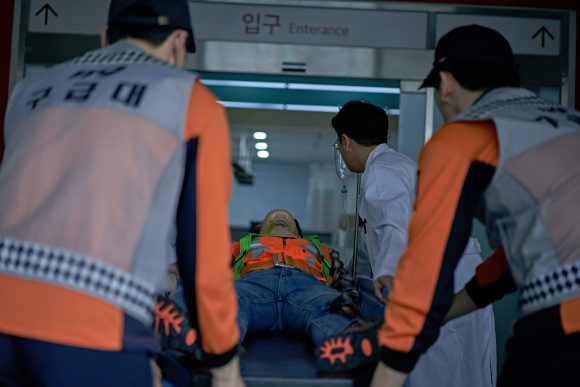Six out of 10 fall deaths last year occurred in people over the age of 65.
According to the ‘Safety Report 2021 for Koreans’ issued by the National Statistical Office, the elderly aged 65 and over accounted for 63.4% and 45.9% of all fall deaths and hospitalizations, respectively. In particular, the number of fall patients aged 75 and older increased more rapidly than the population aged 65-74, more than doubling from 61,000 in 2010 to 128,000 in 2018.
Experts interpret this as a result of the aging of the population and emphasize the importance of preventing and treating osteoporotic fractures as well as preventing falls. When osteoporosis becomes severe, bones can be easily broken even by a slight slip or impact, and once a bone is broken, it can lead to re-fracture, which can threaten the quality of life as well as life.
What is the ‘super-risk group for osteoporotic fractures’?
Professor Seok Sang-yoon of the Department of Orthopedic Surgery at Daejeon Eulji University Hospital said, “As we age, we suffer from osteoporosis, which is a hole in the bones that support our body. Fractures can cause various complications and can lead to death, so there is a recent trend to call for special attention to the ‘ultra-high-risk group of osteoporotic fractures’, which have a particularly high risk of fracture.”
Newly defined in 2020, the ‘ultra-high-risk group for osteoporotic fractures’ separates the osteoporotic patients with a particularly high risk of osteoporotic fractures from the existing high-risk groups.
Osteoporosis experts at home and abroad, such as the American Society of Clinical Endocrinology/Endocrinology and the Korean Society for Bone Metabolism, classified the very high-risk group for osteoporotic fractures as ▲ those who experienced a fracture within the last 12 months or ▲ fractures during osteoporosis treatment ▲ Multiple fractures with fractures occurring at multiple sites ▲ Patients who experienced a fracture while taking drugs that cause skeletal damage such as long-term use of corticosteroids ▲ Bone mineral density (T-score) diagnosed as below -3.0 or ▲ Major osteoporotic fracture risk of 30 by FRAX (Fracture Risk Assessment Tool) % or higher, or a hip fracture risk of 4.5% or higher;
Osteoporotic fractures that even a slight ‘knock’ fall can lead to death
Elderly patients should be careful about complications caused by fractures. If they lie on a bed due to a fracture, pressure sores, pneumonia, urinary tract infection, and leg vein thrombosis may occur.
In addition, if pulmonary embolism occurs in which the pulmonary blood vessels are blocked, sudden death may occur. It is known that 1 in 6 hip fractures in people over the age of 50 will die within 1 year.
Once a bone is broken, the risk of breaking it again is also high. Osteoporosis patients who have suffered a fracture already have weakened bones throughout their body, and according to research, the chance of breaking a bone again within a year is as high as 25%.
Re-fractures can occur in various areas such as the spine, hip, and wrist, and it is known that 72% of re-fractures occur in the spine. In addition, the risk of a femoral fracture increases by 3.8 times when a vertebral fracture occurs, and the risk of a contralateral femoral fracture increases by 3 times when a femur fracture occurs.
The mortality rate from the first femoral fracture was 15.9%, but increased to 24.1% for re-fractures. In addition, the mortality rate within one year after hip re-fracture in Korea is 17% (27.9% for men, 14.3% for women), and the mortality rate from vertebral fractures is also fatal at 5% (11% for men, 4% for women).
‘Ultra high-risk group’ needs strong treatment to prevent fractures
Osteoporosis treatment is divided into treatments that inhibit the destruction of old bones or create new ones.
Recently, a dual mechanism of treatment option that can inhibit bone resorption and promote bone formation at the same time has emerged. As a result, the academic community has established a treatment strategy for the very high-risk group of osteoporotic fractures with very imminent fractures, enabling effective treatment to reduce the risk of fractures more quickly.
Lomosozumab, which is recommended as the first-line treatment for the very high-risk group for osteoporosis in Korea and abroad, is a subcutaneous injection that is administered once a month, up to a total of 12 times for a year. It rapidly and powerfully increases bone density through the dual mechanism of inhibiting bone resorption and promoting bone formation at the same time.
In actual clinical trials, about 7,200 osteoporotic patients treated with lomosozumab for 12 months reduced the risk of new vertebral fractures by 73% compared to patients treated with placebo.
Also, in a study of postmenopausal women with osteoporosis, hip joint strength (2.5%) increased in the lomosozumab group at 12 months of treatment, and total hip joint, femoral neck, and lumbar bone density significantly increased compared to the control group (Teriparatide).
Professor Seok Sang-yoon of the Department of Orthopedic Surgery at Daejeon Eulji University Hospital said, “The goal of treatment is to rapidly lower the risk of fracture through strong and intensive treatment such as a dual-action mechanism for the very high-risk group of osteoporosis fractures.” “Osteoporosis is high blood pressure As it is a disease that requires lifelong treatment like diabetes and diabetes, it is necessary to continuously manage fracture prevention through bone resorption inhibitor treatment even if patients who started treatment with osteogenic agents in the ultra-high-risk group become high-risk,” he emphasized.
By Kim Yong-joo, reporter [email protected]
Copyright ⓒ ‘Honest knowledge for health’ Comedy.com (https://kormedi.com) / Unauthorized reproduction-redistribution prohibited
–


